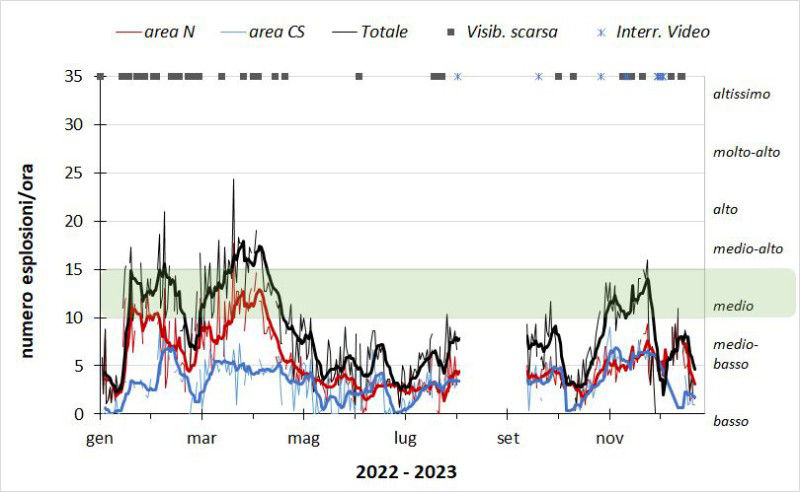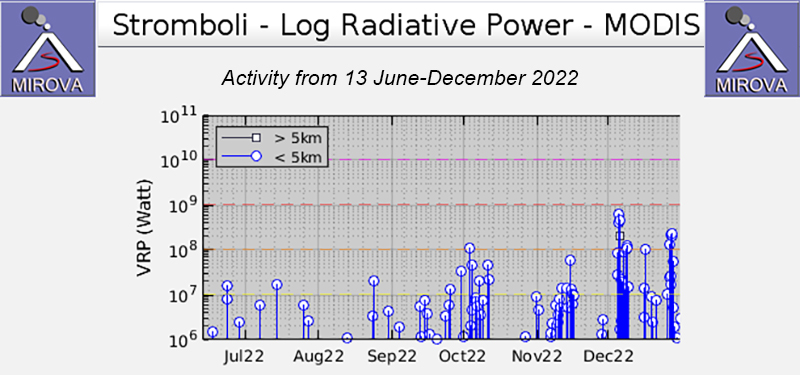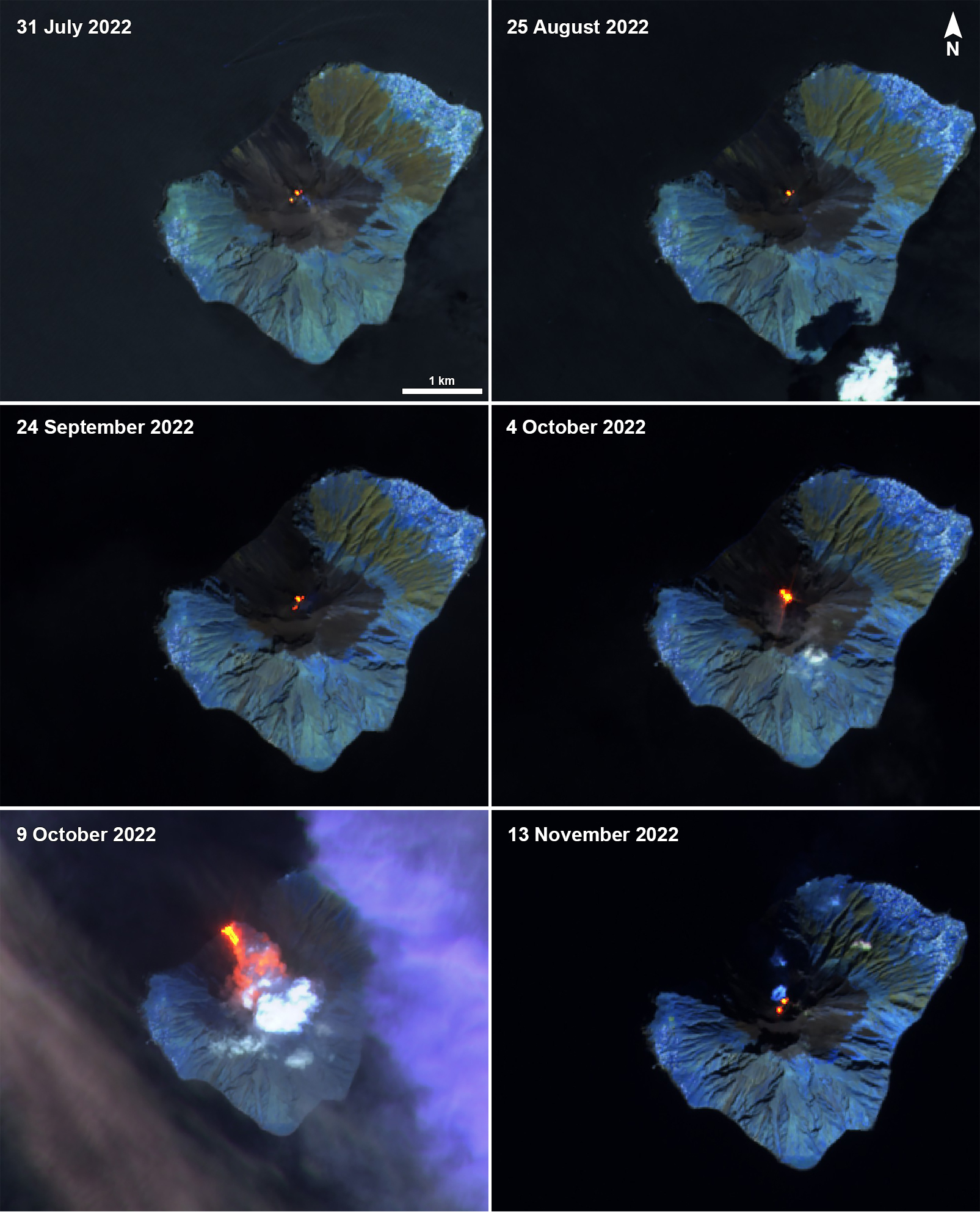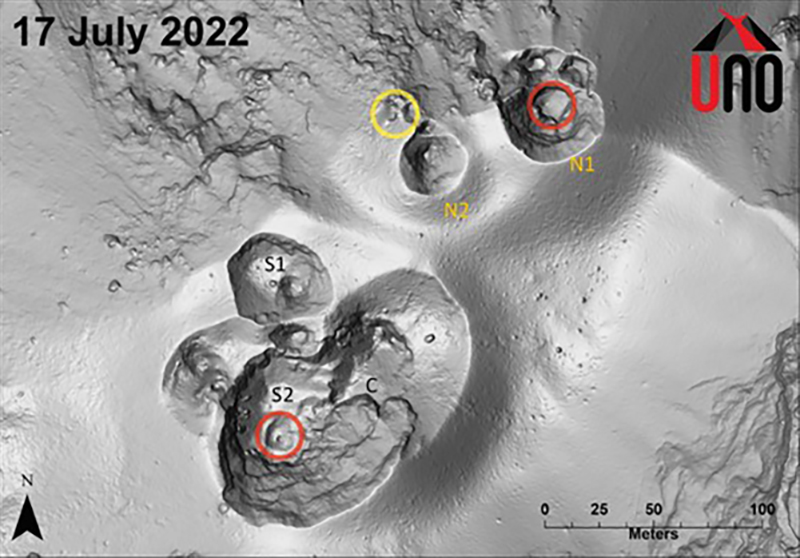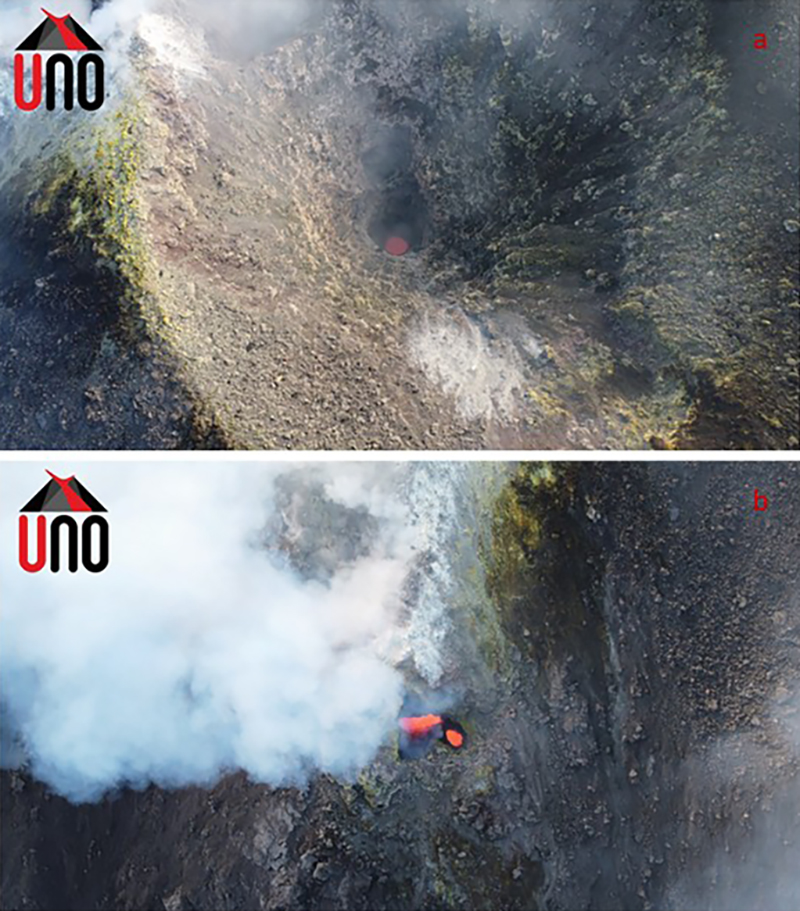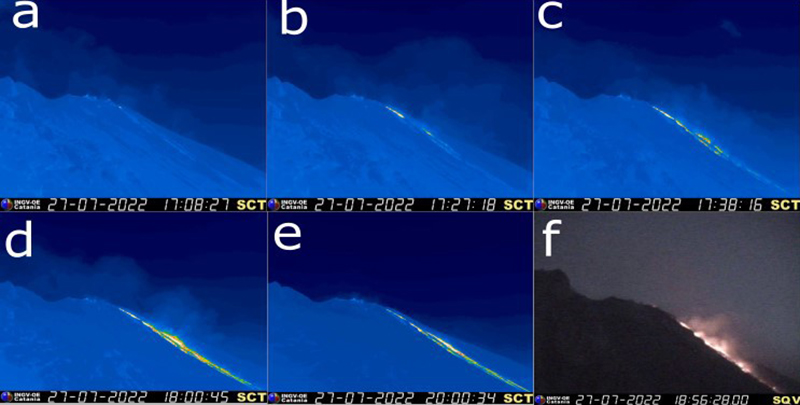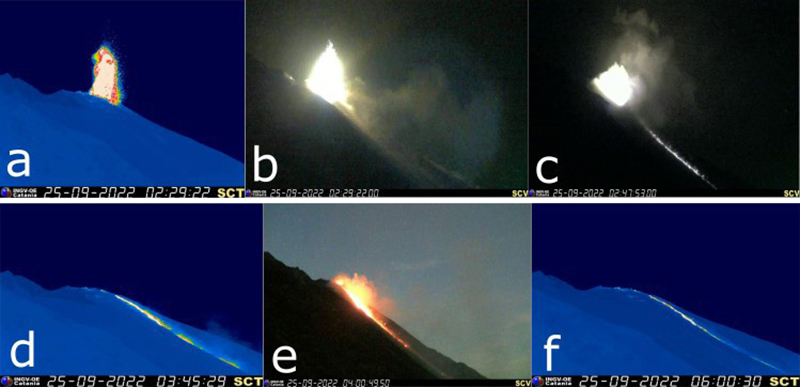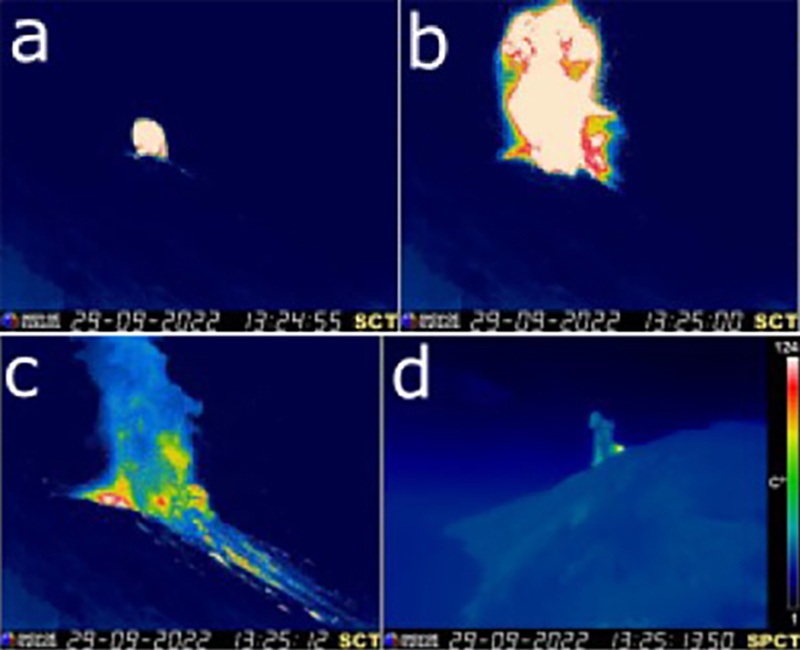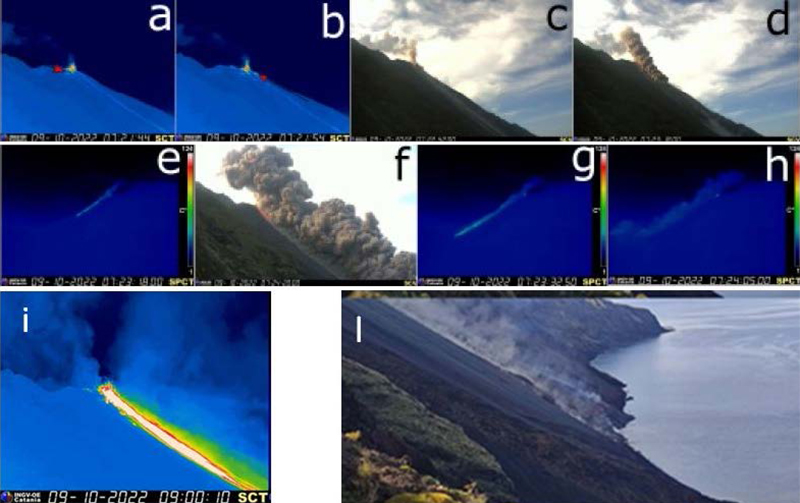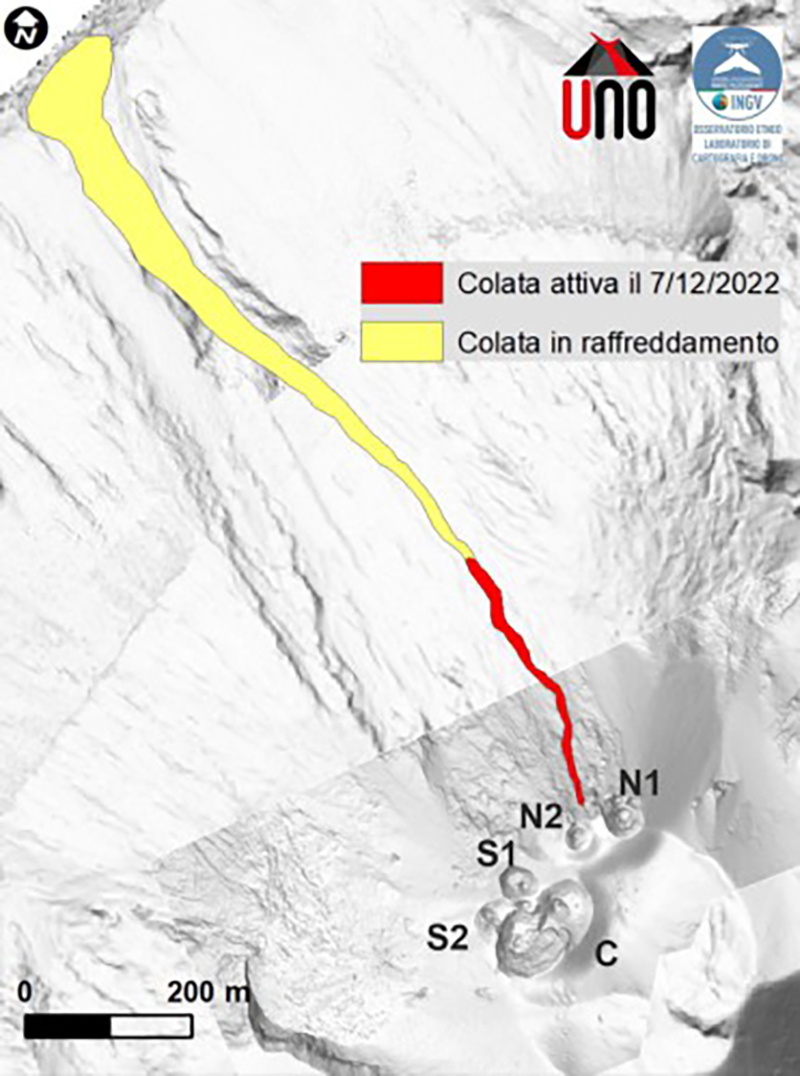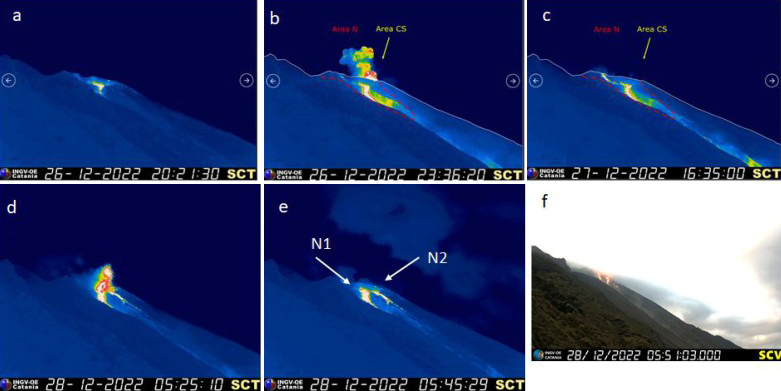Report on Stromboli (Italy) — February 2023
Bulletin of the Global Volcanism Network, vol. 48, no. 2 (February 2023)
Managing Editor: Edward Venzke.
Edited by Kadie L. Bennis.
Stromboli (Italy) Frequent Strombolian explosions persist with lava flows during July-December 2022
Please cite this report as:
Global Volcanism Program, 2023. Report on Stromboli (Italy) (Bennis, K.L., and Venzke, E., eds.). Bulletin of the Global Volcanism Network, 48:2. Smithsonian Institution.
Stromboli
Italy
38.789°N, 15.213°E; summit elev. 924 m
All times are local (unless otherwise noted)
Stromboli, located in Italy, has exhibited nearly constant lava fountains for the past 2,000 years; recorded eruptions date back to 300 BCE. Eruptive activity occurs at the summit from multiple vents, which include a north crater area (N area) and a central-southern crater (CS area) on a terrace known as the ‘terrazza craterica’ at the head of the Sciara del Fuoco, a large scarp that runs from the summit down the NW side of the volcano-island. Activity typically consists of Strombolian explosions, incandescent ejecta, lava flows, and pyroclastic flows. Thermal and visual monitoring cameras are located on the nearby Pizzo Sopra La Fossa, above the terrazza craterica, and at multiple flank locations. The current eruption period has been ongoing since 1934 and recent activity has consisted of Strombolian explosions and incandescent ejecta (BGVN 47:07). Activity described here includes daily explosions, incandescent ejecta, spatter activity, and lava flows during July through December 2022 using reports from Italy's Istituto Nazionale di Geofisica e Vulcanologia (INGV) and various satellite data.
Frequent explosive activity continued throughout the reporting period, generally in the low-to-medium range, based on the number of hourly explosions in the summit crater (figure 242, table 15). Intermittent thermal activity was recorded by the MIROVA (Middle InfraRed Observation of Volcanic Activity) analysis of MODIS satellite data (figure 243). There was a gradual increase in thermal power and frequency from September through October and again during early-to-mid November. The strongest thermal activity was detected during early December and continued at a high level through the end of the month. These thermal activity increases likely reflected the period in which active lava flows were reported in the Sciara del Fuoco that preceded intense spattering activity. Sentinel-2 infrared satellite imagery captured relatively strong thermal hotspots at the two active summit craters on clear weather days, showing an especially strong event on 6 October, where a lava flow covered much of the NW flank (figure 244).
Table 15. Summary of type, frequency, and intensity of explosive activity at Stromboli by month during July-December 2022; information from webcam observations. Courtesy of INGV weekly reports.
| Month | Explosive Activity |
| Jul 2022 | Typical Strombolian activity with spattering. Explosions were reported from 3-4 vents in the N area and 2-3 vents in the CS area. The average hourly frequency of explosions ranged from low to medium (1-8 events/hour). The intensity of the explosions varied from low (60 m high) to medium (less than 150 m high) in both the N area and the CS area. |
| Aug 2022 | Typical Strombolian activity with spattering. Explosions were reported from 2 vents in the N area and 2 vents in the CS area. The average hourly frequency of explosions ranged from low to medium (2-10 events/hour). The intensity of the explosions varied from low (less than 80 m high) to medium (less than 150 m high) in both the N area and the CS area. |
| Sep 2022 | Typical Strombolian activity with spattering. Explosions were reported from 3 vents in the N area and 2 vents in the CS area. The average hourly frequency of explosions ranged from low to high (3-10 events/hour). The intensity of the explosions varied from low (less than 80 m high) to medium (less than 150 m high) in both the N area and the CS area. |
| Oct 2022 | Typical Strombolian activity with spattering and lava flows. Explosions were reported from 3-4 vents in the N area and 1-2 vents in the CS area. The average hourly frequency of explosions ranged from low to high (1-12 events/hour). The intensity of the explosions varied from low (less than 80 m high) to high (more than 150 m high) in the N area and low to medium (less than 150 m high) in the CS area. |
| Nov 2022 | Typical Strombolian activity with spattering. Explosions were reported from 3-4 vents in the N area and 2 vents in the CS area. The average hourly frequency of explosions ranged from low to high (2-16 events/hour). The intensity of the explosions varied from low (less than 80 m high) to high (more than 250 m high) in both the N area and the CS area. |
| Dec 2022 | Typical Strombolian activity with spattering and lava flows. Explosions were reported from 3-4 vents in the N area and 1 vent in the CS area. The average hourly frequency of explosions ranged from low to medium (1-11 events/hour). The intensity of the explosions varied from low (less than 80 m high) to high (more than 150 m h high) in the N area. |
Activity during July-August 2022. Variable low-to-medium Strombolian explosions were reported in both the N and CS crater areas also accompanied by spattering activity (figure 245). The N1 and S2 craters, both of which have two emission points, generated low to medium intensity explosions that ejected fine to coarse material 30-150 m above the crater. Explosions at the N1 crater ejected coarse, partially reworked material mixed with fine ash, which remained suspended a few tens of meters above the crater and dispersed as a light-colored plume, eventually falling in the innermost vent area. Explosive activity at the S2 crater was sporadic and mainly consisted of mainly reworked fine ash and light brown ash plumes. Craters N2 (in the N area), and C and S1 (in the CS area) exhibited frequent degassing and were less explosive. INGV reported that crater incandescence from the degassing craters was visible during the day and night (figure 246). Explosions on 18 July were higher energy and consisted of mainly juvenile material. An explosive sequence at N2 on 25 July was characterized by continuous, diffuse degassing. Explosions affected both the N and CS crater areas; at 0256 an explosion of coarse mixed with fine material was detected at the S2 crater; at 0256 a more intense explosion was detected in the N2 crater, ejecting material 300 m above the crater, and falling along the Sciara del Fuoco. This stronger explosion lasted about two minutes and was accompanied by a lava fountain that gradually decreased in intensity and became spattering after about six minutes. At 0257 a pyroclastic flow originating from the deposits of the previous explosion extended toward the coastline for a few hundred meters. A low intensity explosion with fine material was detected at 0258. The overall duration of the explosive sequence lasted about eight minutes.
On 27 July a lava overflow was reported in the N2 crater area. After the explosive sequence on 25 July, spatter activity was reported in the N2 crater area which, by 1708, had turned into a lava flow (figure 247). Two branches reached the central part of the Sciara at an elevation of 600 m. By 2000 the flow had stopped. During 8-14 August the N2 crater showed sporadic explosions consisting of low intensity coarse material and weak spattering. Some observational data was lost from webcams at 400 m elevation during the latter half of August due to bad weather damaging an optical fiber link on 12 August.
Activity during September-October 2022. Hourly Strombolian explosions were variably low-to-moderate in intensity. Ejected material rose between 80 to more than 150 m above the crater and generally consisted of coarse material mixed with fine ash. In the northern crater area, N1 crater generally showed little degassing activity, but there were episodic ash emissions observed on 9 September. The N2 crater showed intense gas-and-steam emissions and few explosions consisting of lava fragments. Gas-and-steam emissions were relatively low in the CS area. Weak infrequent ash emissions consisting of some coarse material mixed with fine ash were sometimes observed from at least two vents near the S2 crater. Near the central crater (C) gas-and-steam emissions were almost absent.
On 25 September a strong explosion from a vent in the N2 crater was accompanied by intense spattering. Shortly afterwards a lava overflow was reported in the N crater area along the central and summit of the Sciara del Fuoco, lasting around four hours (figure 248). A strong explosion was observed in the N2 crater area on 29 September (figure 249). The first pulse was the most energetic, lasting about eight seconds and ejecting fine material 300 m above the crater that fell along the Sciara del Fuoco. This activity was followed by at least four low-intensity explosive events that ejected material less than 100 m above the crater. The N2 crater showed continuous spattering after the 29 September explosion.
On 3 and 4 October two lava flows were observed at the N crater area. The first flow originated from a fissure on the external cone in the N2 crater area in the Sciara del Fuoco on 3 October. As the lava flow grew in volume, a lava channel formed along the Sciara del Fuoco up to the coast. By 1600 UTC the lava flow had begun to cool. On 4 October a new lava flow from the N crater area overlapped the previous flow and loose material moved along the Sciara del Fuoco. Another lava flow was observed from the N2 crater area beginning on 0721 UTC on 9 October. At 0722 UTC a pyroclastic flow began due to a collapse on the edge of the N2 crater that faced the Sciara del Fuoco (figure 250). The pyroclastic flow moved rapidly and reached the coastline by 0723 UTC, spreading out over the sea a few hundred meters. The pyroclastic flow was then followed by a strong lava flow that developed into two branches and reached the sea in a few minutes.
The effusive activity that began on 9 October developed a lava flow field that consisted of numerous overlapping minor flows. Frequent collapses of material occurred from the lava channel that was formed during 3-4 October, rolling along the Sciara del Fuoco, and reaching the coast, forming a delta. As the hot material interacted with the sea, lobes formed, which generated gas-and-ash emissions that rose to 1 km altitude. Low-level intense spattering activity was variable and contained within the N2 crater with occasional phases of lava fountaining. By 14 October the eruptive activity markedly decreased. INGV reported that by 15 October, according to surveillance cameras and field observations, the flow along the Sciara del Fuoco had stopped. On 16 October the spattering activity in the N2 crater had stopped. After the spattering ended there were numerous series of low-intensity ash events in the N2 crater. Observations from a drone overflight on 16 October revealed new fractures with thermal anomalies between N1 and N2. During 21-22 October two emission points showed low-intensity explosive activity with coarse material and intense spattering activity in the N2 crater area.
Activity during November-December 2022. Explosive activity persisted in both the N and CS crater areas consisting of coarse-to-fine material; spattering activity mainly occurred in the N crater area. The N1 crater contained two emission points that produced explosions of low-to-medium intensity that ejected coarse material up to 120 m above the crater. The N2 crater also contained two emission points that generated low-to-high intense explosions where material sometimes reached more than 150 m above the crater. The S2 crater generated explosions that ejected fine material mixed with coarse material 150-250 m above the crater. No explosive activity was noted in the S1 and C craters. Continuous spattering was reported on 2 November and became more intense during 6 and 8-9 November. A lava flow was observed on 16 November beginning at 0705 UTC, based on seismic data. Due to bad weather conditions during the latter half of the month, visual observations of the summit craters could not be made.
During December, only one explosion was noted in the CS crater area; explosions and spattering mostly occurred in the N crater area. On 4 December at 1410 UTC a lava flow was observed during the afternoon in the upper part of the Sciara del Fuoco, followed by a small flow starting around 1428 UTC that traveled along the central part of the Sciara del Fuoco (figure 251). The two lava flows were 50 m and 80 m below the crater rim of the N crater, respectively, and reached the coast around 1600 UTC. Pyroclastic flows were detected at 1431 and 1518 UTC, the latter of which originated from a fracture on the NW flank of the N crater area within the Sciara del Fuoco and reached the coast in a few seconds. They traveled along the Sciara del Fuoco and then several hundreds of meters into the sea. Accompanying gas-and-ash plumes rose to 1 km altitude. Intense spattering activity was reported hours after the lava and pyroclastic flows began.
The effusive activity from 4 December was observed at least through 8 December, based on webcam images. Both explosive and effusive activity was observed in the N crater area from three vents within the Sciara del Fuoco after 4 December. Additionally, intense spattering activity accompanied the lava flow. No explosive activity was observed in the CS area. Activity that occurred during 4-9 December generated a collapse of material on the N area of the crater terrace, and to a lesser extent, in the CS terrace.
On 16 December at 1208 UTC, after intense spattering activity in the N crater area near N2, a lava flow began to flow in the central area of the Sciara del Fuoco. The flow gradually decreased in volume after a few hours before stopping. Similarly, at 0842 on 19 and 1447 on 21 December (UTC), two lava flows were observed from the vents in the N crater area that spread along the central area of the Sciara del Fuoco after intense spattering activity near the N2 vent. The only explosive activity that was detected in the CS crater area occurred on 22 December, when fine material mixed with coarse material was ejected higher than 150 m above the crater. A lava flow during 26-28 December traveled to 400 m elevation and, similar to previous lava flow events, was preceded by intense spattering activity from the N1 vent that gradually intensified (figure 252). The lava flow began at 2013 UTC on 26 December and had ended by 0830 on 28 December. The flow was mainly fed by the N1 vent and to a lesser extent, by the N2 vent during 0505-0712 UTC.
Geological Summary. Spectacular incandescent nighttime explosions at Stromboli have long attracted visitors to the "Lighthouse of the Mediterranean" in the NE Aeolian Islands. This volcano has lent its name to the frequent mild explosive activity that has characterized its eruptions throughout much of historical time. The small island is the emergent summit of a volcano that grew in two main eruptive cycles, the last of which formed the western portion of the island. The Neostromboli eruptive period took place between about 13,000 and 5,000 years ago. The active summit vents are located at the head of the Sciara del Fuoco, a prominent scarp that formed about 5,000 years ago due to a series of slope failures which extends to below sea level. The modern volcano has been constructed within this scarp, which funnels pyroclastic ejecta and lava flows to the NW. Essentially continuous mild Strombolian explosions, sometimes accompanied by lava flows, have been recorded for more than a millennium.
Information Contacts: Istituto Nazionale di Geofisica e Vulcanologia (INGV), Sezione di Catania, Piazza Roma 2, 95123 Catania, Italy, (URL: http://www.ct.ingv.it/en/); MIROVA (Middle InfraRed Observation of Volcanic Activity), a collaborative project between the Universities of Turin and Florence (Italy) supported by the Centre for Volcanic Risk of the Italian Civil Protection Department (URL: http://www.mirovaweb.it/); Sentinel Hub Playground (URL: https://www.sentinel-hub.com/explore/sentinel-playground).


